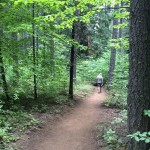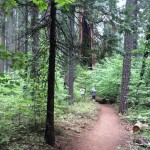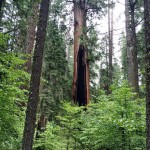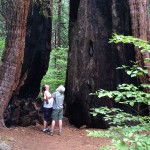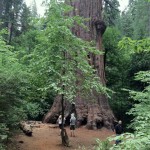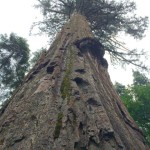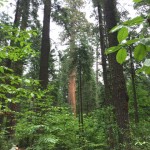 The thing about the Sequoias, or why you cannot photograph the Sequoiadendron giganteum.
The thing about the Sequoias, or why you cannot photograph the Sequoiadendron giganteum.
Recently my family and I spent a delightful few days of vacation in California’s gold country in the foothills of the Sierra Nevadas. While there we took a day trip up to Calaveras Big Trees State Park where we hiked the less visited South Grove trail. Thanks to some intense activism this grove of Giant Sequoias is entirely unlogged and remains largely in its wild state. It is, with the exception of the trail and a few signs, almost exactly like hiking in a virgin forrest. I’ve been lucky to spend a lot of time in the Sierras, but this grove is to my knowledge singular. What follows is my attempt to capture the experience of hiking the trail in words. I highly recommend you do not take me at my word, that you do not believe what I have written here. Rather I would prefer you hike the trail for yourself.
As you wander down the trail, the low woods, mostly dogwood and small pines, keep your horizons close. There are a large amounts of dead trees scattered about the forrest floor and plenty of new ones working their way up from the decaying material. The ferns and bushes dot the ground, but do not fully cover it. The whole effect is one of a forest that grows no more than three meters above the ground. It’s not unlike walking through a neighbor’s garden that has been left unattended for years until it’s shape has pushed past any human convention into a wonderful random jumble.
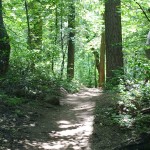
No sooner than you seen this, you start to notice that this “garden” is underpinned by dark vertical columns. These are the mature pines, sugar pine and ponderosa mostly, with the occasional lodgepole pine added for splash. In about equal measure with these pines are the cedars which grow in clumps like nurseries with large parents overlooking tiny rivers of baby trees, most of them shorter than a man.
__
So now your view becomes used to these columns shooting darkly upwards through the light green forest floor. As your eye traces their vertical lines upwards you notice they branch out at around three meters and point their way upwards in long thin triangles. The tops, some of them 200 feet or more above your head, can be seen only from a distance. But these are not unfamiliar trees. These are the taller more wild cousins of the Christmas trees that have been decorating our homes every winter for millennia. We know these trees, we live with them for a few weeks to a month every year. True they are quite a bit larger than the ones in ours houses, but they are essentially scaled up versions of what we know. Scaled up the way 100 tables at a wedding reception are not all that different from the single table you use at home. It is simply more of the same.
__
But then, as you wind your way along the trail, you start to see still larger shapes looming out of the forest floor. At first they look like normal trees, but then as you approach them they start to get wider and wider until your mind is so startled by the impossibility of a tree at those dimensions that it forces you to pay attention. These are trees so large they trigger that part of our brain we use to warn us of an incoming threat. Trees that are so large they literally scare you into seeing them. You’ve now arrived at the Giant Sequoias.
__
When you get up close to one, you notice a Giant Sequoia doesn’t look like the other trees. They stand like some weird alien creature that has been imported to the forest. They resemble the other pines pretty much the same way that an elephant covered in fur could be mistaken for a wolf.
__
These trees are so large that you cannot fit them into a single photograph. They simply will not fit. If you shoot one up close all you get is a trunk. These shots look just like a regular tree only shot much closer. If you add a human in front for a sense of scale the tree takes on the appearance of an amusement park model. Its so large it looks more like architecture than nature. If you point your camera upwards then the top will be hidden behind the bottom branches (some of which are as large as entire trees nearby). If you step back far enough to capture the entire height then the sequoia resembles an ordinary large tree, reducing the apparent height of the huge pines around it to the size of seedlings. If you add humans to this shot they appear too distant for the eye to scale, or they’ll be so small as to not matter. Another pixel lost in a sea of pixels.
__
No matter how far back you get or what lens you use, you cannot capture a Sequoia in a single shot. They are so large they can only be pieced together by the mind of the observer. Its about then that you discover they’re not as much a tree as they are living geology. To stand next to one as it extends upward into the heavens at that impossible height is to stand next to a million years. It’s not a thing. It’s too big for that. It’s a living metaphor. It’s a rock wall that lives and breathes. It is a battleship made of living wood, set adrift in a remote and arid sea.
__
As you come across them on the trail, sometimes alone surrounded by a coterie of lesser trees, sometimes in dense clumps of two or three, you start to run out of superlatives. Each tree as it is revealed to you is so impossible that you simply run out of words. As with photography, these trees are so huge you cannot capture them language. They will not fit within a single sentence. And after a few tries you realize even whole paragraphs won’t do. Finally you get to the point were all you can do is stand at the base of such a tree and stare upwards in mute and lensless wonder. Every attempt you make to describe these trees will fail. They simply can not scale down to human size. Even a holiday as large as Christmas cannot contain them.
__
No wonder the first white men who saw the Giant Sequoias were not believed. They had to cut one down to prove they existed, and then they tried to cut the rest down because trees that large are a threat. They’re too big. They don’t fit our mechanized world. They’re not just tremendously old, they are time itself. Many of them were born long before Jesus walked this earth, and they come from a race as ancient at the dinosaurs. You can beat against one with your fists a thousand times and they will not notice. They are too old, too indifferent. No wonder we chopped them down. These trees don’t know we exist. Nothing makes a white man’s blood boil faster than irrelevance.
__
Finally, this is what you take with you as you walk out of the forest with a camera full of impossible photos that no one will believe; your irrelevance. You have gazed upon a thousand years. Everything you do in this life will be as nothing to these giant creatures. Short of destroying one, you will never gain their notice, and you will never find their approval even if you searched a thousand years. Such a thing does not exist. You are irrelevant. You are nothing. You are a part of the great and beautiful forest we call life, but you are not the biggest part, nor the most important.
__
And in the end this is what the Giant Sequoia teaches us; our rightful place.

